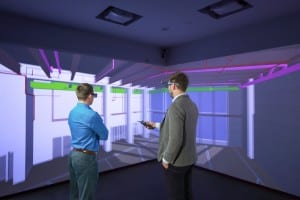
Construction manager Suffolk’s “Cave” Smart Lab allows clients to virtually set foot inside buildings before they break ground and allows architects and project teams to identify challenges in advance. Photo by J. Michael Worthington Jr.
It has given more freedom to architects and allowed construction firms to communicate more effectively throughout a project’s lifespan. And for a Boston digital ad agency, it creates that “wow” factor that clients are increasingly seeking.
Virtual and augmented reality applications are changing design and the way projects are understood today, giving the industry a new high-tech understanding of real estate.
The technologies have two distinct applications: virtual reality totally immerses a user within a created world that gives them 360-degree views, disconnecting them from their surroundings. Augmented reality layers information in 3-D graphics onto the real world and a person’s present and physical experience.
Boston-based architects Arrowstreet has been using VR/AR for nearly three years for two objectives: as a way to restructure meetings and create more a more flexible work arrangement and as a way to allow clients to get the feel of a space not possible from two-dimensional drawings.
“I think we as architects sometimes forget that it can be difficult to read drawings,” said Scott Pollack, an Arrowstreet principal. “As good as a beautiful 2-D representation can be, it’s not the same as being in the space. And for a long time, people were not going to discover what a place was like until it was actually built. There’s a control and a temporal quality to when you’re actually in a place.”
Getting a client to strap on the virtual headset is only half the battle. Creating content that is worth their time for that experience is crucial, said Amy Korte, an Arrowstreet principal.
“You really have one shot with our clients to get them into the virtual reality headset and that content has to be exquisite,” she said. “There’s certain ways that we can represent things internally to us inside the office, but when we put our clients into the headsets or into an AR experience it has to be the quality has to be so much better than anything they can experience on paper.”
In architecture, good design still comes from a good idea. However VR/AR open up new ways architects can create buildings.
“As someone who’s been doing this for 30 years, it is giving us a freedom on a design and constructability perspective that I don’t think we would have ever taken the risk on before,” Pollack said. “It was almost impossible to actually know what it [the space] was going to be. It gives us more freedom on the design side to do things. Not that people didn’t imagine before, but it was hard to have confidence that we could draw in a way that the contractor was actually going to be able to build.”
The firm added a data scientist on staff to assist with analysis of data from VR/AR experiences.
VR as a Construction Tool
Roxbury-headquartered Suffolk has been implementing VR/AR for two years in its role as Greater Boston’s largest construction manager.
“We use it as a way to communicate during the planning phase, during early conversation phases and have now started as we use it more throughout the life cycle of the project,” said Chris Mayer, executive vice president and chief innovation officer at Suffolk.
The creativity of using VR has not reached its peak. It will take time to understand best practices and to improvise, Mayer said.
“When television came online, the advertisements were essentially stand up radio reads,” he said. With color TV, “it took a long time to really figure out how you take advantage of the medium to be able to communicate more effectively. When we first all moved to the web, a lot of it was taking what we’d done in print and pushing it out to a digital platform.”
The VR/AR adds to what Suffolk has sought to do all along: understanding their clients. The feedback has been positive so far, Mayer said.
“One of the things that is surprising is how easy it is to engage and how the value that people start to see out of it,” he said.
A Gamer’s-Eye View of Real Estate
Boston-based digital ad agency provides VR/AR experiences from gaming-type views to more practical needs, such as supplementing architectural drawings.
“We definitely think it does add a decent excitement to what that overall project or experience might be,” said Paul Saraiva, executive producer at Inphantry. “It definitely helps solidify the ‘wow’ factor for that client.”
The commercial real estate industry is taking to VR because it enables clients to virtually tour properties without leaving their homes or offices. But finding the right people to support the VR/AR division of a company can be difficult, Saraiva said.
“That’s an ongoing challenge that we face and I’m sure most AR/VR studios do face especially in the Northeast,” he said. “That’s a challenge for 2018 and beyond.”
Another priority is providing the tools to reach a broader audience, Associate Media Producer Trevor Metcalfe said.
“The device that people are most comfortable with when it comes to VR/AR is a phone,” he said. “People are still developing VR or AR for mobile – that’s the most accessible, but who knows when that could flip?”




 |
| 